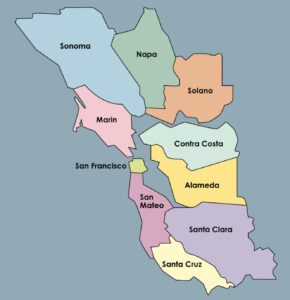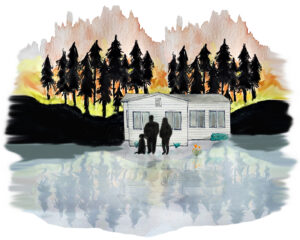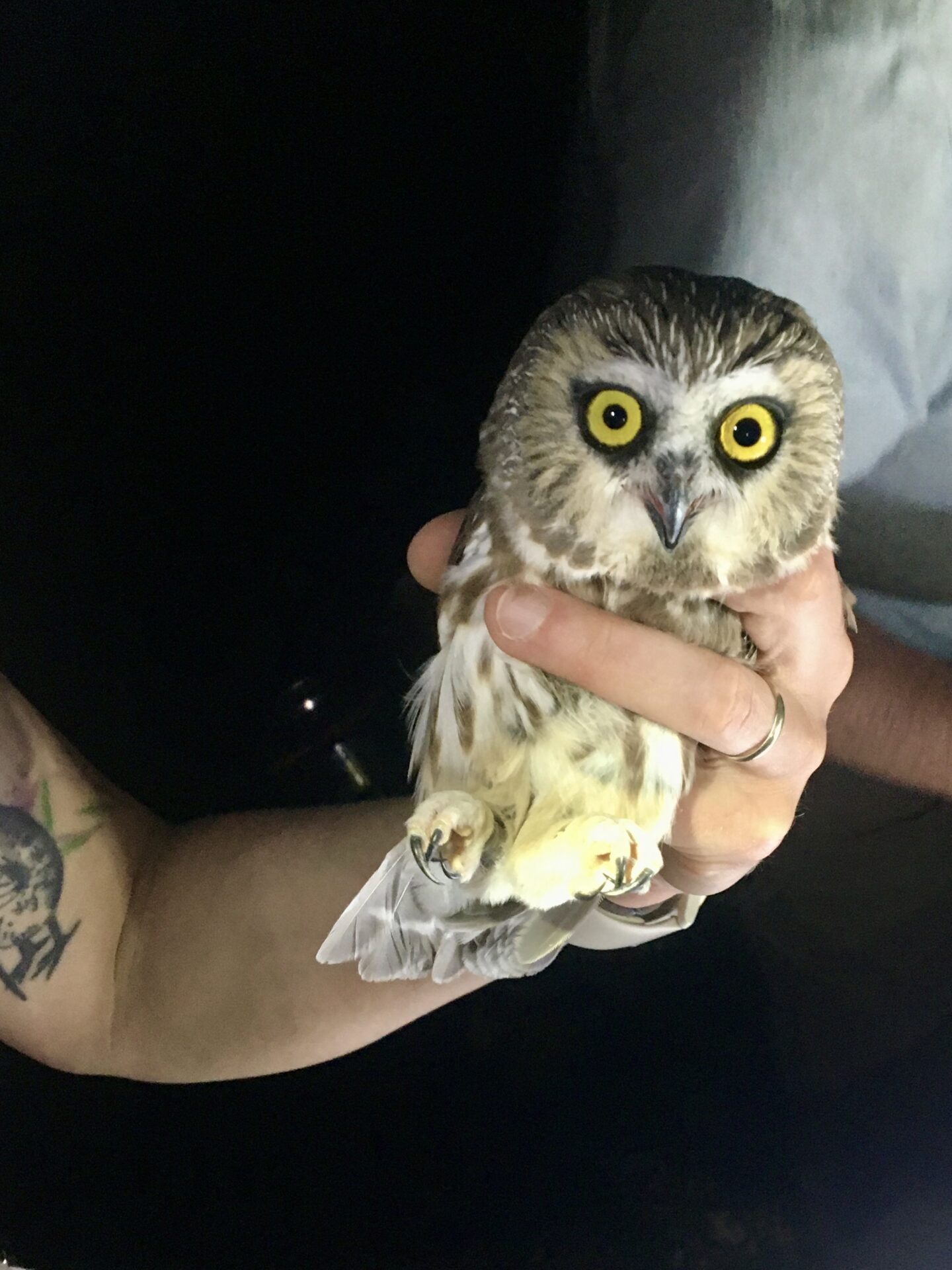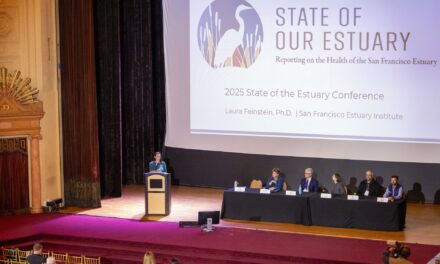Volunteers Catch and Release Tiny Owls For Science

Volunteer Susana de Trapaga (left) extricates an owl from the mist net while Julie Woodruff (center) and volunteer Jeff Robinson offer support. Photo: Amy Moore
This Halloween, biologist Julie Woodruff did not sit on her porch waiting for trick-or-treaters. Instead, she spent the evening in a dark Sonoma County forest waiting to intercept northern saw-whet owls. Woodruff leads a banding project to catch and track these migrating owls, relying on volunteers from the community to advance her research as citizen scientists.
Since late September, Woodruff and a group of volunteers have spent four nights a week, from just before sunset until nearly midnight, waiting for the owls to arrive. No bigger than cans of beans, the tiny birds can be snagged in a fine mesh net that’s erected vertically between two poles. Once caught, they are carefully extracted, fitted with a numbered band, and examined. Volunteers record biological data such as age, sex, and health status before releasing owls back into the night.
Their work fills a void. While the elusive owls have been studied for decades in eastern states, there is far less data on their migration and populations in western states. The data Woodruff and her volunteers record help scientists fill in these gaps and better understand impacts from urban and industrial development, logging, and climate change.
Northern saw-whet owls are moderately vulnerable to climate change, according to Audubon. A warming climate increases the likelihood of wildfires (which burn habitats), spring heat waves (which threaten nestlings), and heavy rains and flooding (which can inundate nests and impede insect foraging).
Lucas Corneliussen, an environmental studies student at UC Berkeley, has been a “bird nerd” since he was 6 years old. He was excited to start banding with Woodruff this season because he’d never seen a saw-whet owl before. Citizen scientists, like the millions of people worldwide who contribute sightings to the bird observation database eBird, can help track global trends in particular birds, he says. “It’s our civic duty to try to protect spaces and species that exist within these various ecosystems,” Corneliussen says.
Other Recent Posts
Who Will Inherit the Estuary? Training for a Rough Future
The six-month program teaches students aged 17 -24 about the challenges facing communities around the SF Estuary, from Stockton to East Palo Alto.
Split Verdict Over State of the Estuary
Habitat restoration and pollution regulations are holding the Bay steady, but the Delta is losing some of its ecological diversity, says SF Estuary Partnership scorecard.
Antioch Desalination Plant Could Boost Local Water Supply
The $120 million plant opened this fall and treats 8 million gallons of brackish water a day, 75% of which is drinkable.
How Cities Can Make AI Infrastructure Green
Data centers fueling AI can suck up massive amounts of energy, water and land, but local policies can mitigate the impact.
What to Know about PFAS in Tri-Valley Water
In this nonfiction comic, explore how the city of Pleasanton is dealing with PFAS- contaminated groundwater.
ReaderBoard
Once a month we share reader announcements: jobs, events, reports, and more.
Artist Repurposes Shoreline Detritus
Courtney Griffith scours beaches and parks for everything from plastic to charcoal, mangled ropes and burnt wood to use in her work.
Woodruff began banding the owls in 2010 for her master’s project. The first night, she and the lead researcher netted a couple of owls on a preserve near Chico. “I was hooked. They’re just a little nugget of adorableness,” she says.
Northern saw-whet owls are about 7 to 8.5 inches in length. They weigh as little as two pieces of bread and have soft downy feathers and large yellow eyes that swivel on heads that can turn nearly 360 degrees.
Motivated by the dearth of local information about northern saw-whet owl migrations, Woodruff continued monitoring owls in Chico, then started her own banding station in the East Bay in 2018. Last year, Woodruff opened a banding site in the Pepperwood Preserve in northern Santa Rosa.
To prepare for this year’s banding, Woodruff scouted the preserve for a site with enough understory to attract owls looking for a safe roosting spot. She selected a location where bunches of young manzanitas, no taller than a 10-year-old, grow beneath tan oaks. The sparse canopy above is ideal, Woodruff explains, because it allows the owls to fly through the area.
Each night of the six-week banding season, volunteers set up the nets just before sunset. Once the sun is down, the banding site is open and Woodruff starts the “caller,” a recording that plays the owl’s call two to three times per second. It sounds like metal against metal, or a knife against a whetstone. The volunteers will listen to this recording for four hours while they wait in the dark, swapping birding stories. Every 30 minutes, they’ll strap on headlamps and check the nets.
On a night in late October, the volunteers spotted the first owl on the third net check, at 7:40 p.m. In the dark, it’s hard to see the tiny bundles. The owls can get very tangled in the fine net. For 15 minutes, volunteer Jeff Robinson painstakingly moved portions of the mist net off the owl’s feathers and wings, careful to minimize stress on the bird.
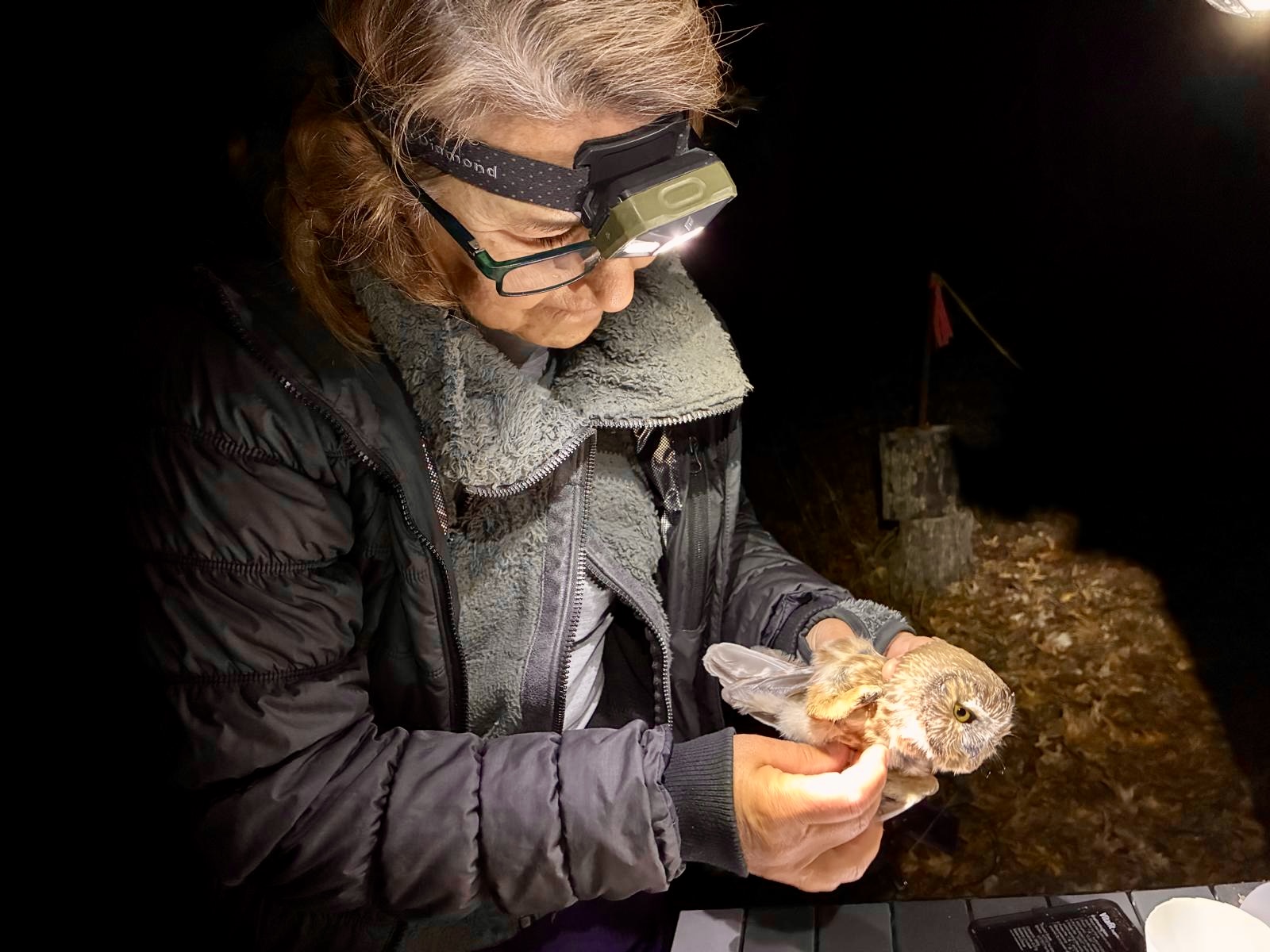
After placing the band on the owl's left ankle, volunteer Susana de Trapaga checked its fit. Photo: Amy Moore
Robinson has built his skills as a bird bander since retiring two decades ago, when he began volunteering for bird counts and rescues. Most days of the week, he engages in citizen science with five wildlife organizations around the Bay Area. Tonight is just one of the two or three nights each week he volunteers for owl banding.
“I’m a morning person, so just staying up at night is the biggest challenge,” Robinson says. But he wouldn’t give it up. “It’s a great privilege to just be able to do this stuff. It’s fascinating to me, and I don’t take it for granted,” he says.
After Robinson had disentangled the bird, Susana de Trapaga, who has participated in owl banding for seven years, slipped it into a small drawstring bag. She brought it to a small camp table holding a large binder and a tackle box filled with miniature metal bands, calipers, a scale, and other measuring devices.
Robinson then closed a numbered metal band around the owl’s ankle. The bands, issued by the USGS Bird Banding Laboratory, allow researchers to track individual birds when they are recaptured. Next, he measured its beak, wing, and tail feathers with small rulers and calipers, while Woodruff noted the measurements in the log and provided guidance. He examined the feathers to determine the owl’s age. If the feathers are uniformly fresh, the bird is likely a “hatch year,” while worn feathers indicate age. Robinson blew on the owl to expose the skin beneath the downy feathers to check for parasites and assess the bird’s body fat. Finally, he slid the tiny owl into an empty apple juice concentrate can and weighed it on a scale.
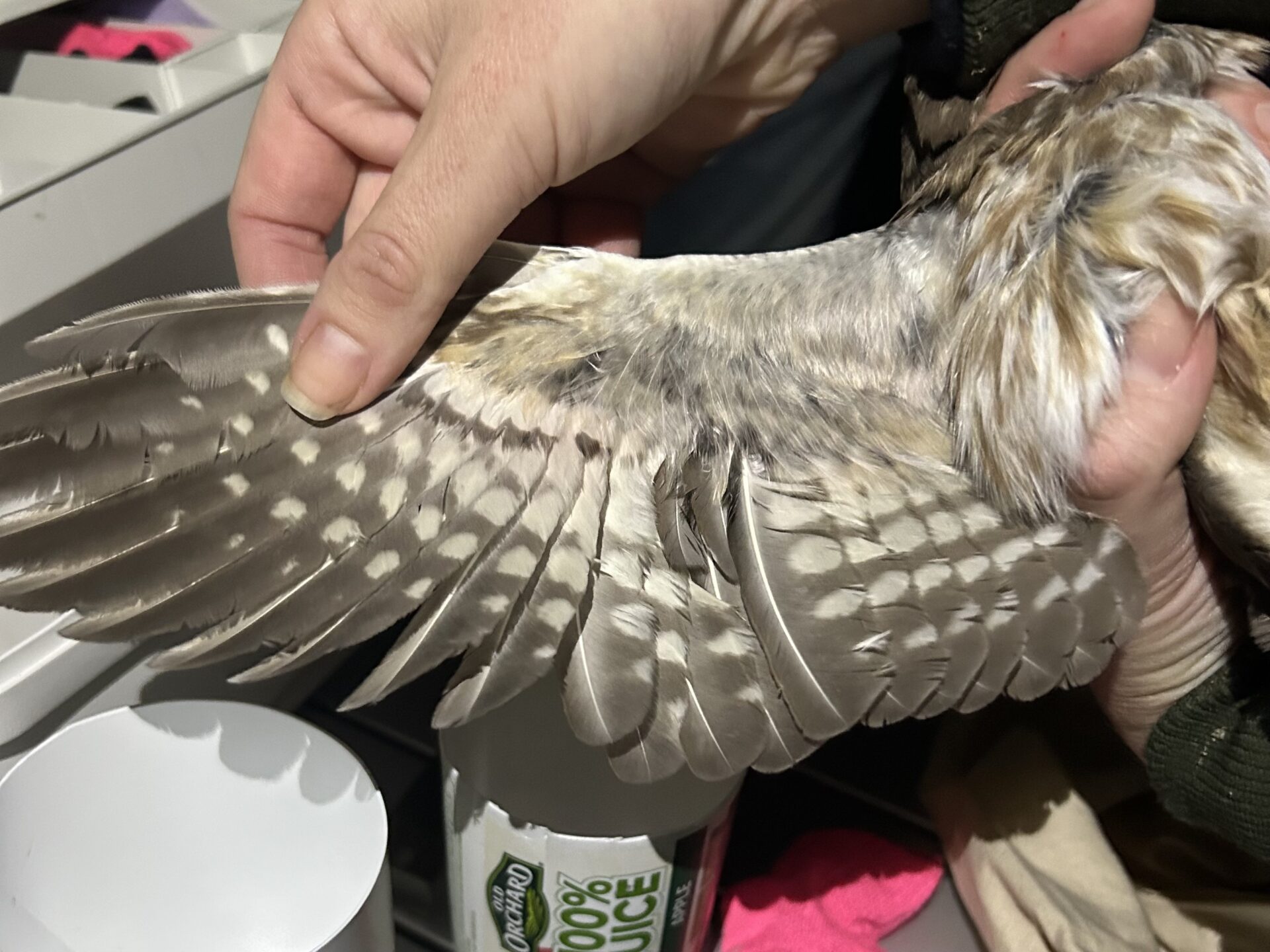
A volunteer extends the owl's wings to assess its age. Photo: Julie Woodruff
The owl grabbed Robinson’s sweatshirt and made soft clicks with her beak. Once all the data had been recorded, Robinson released the owl. It flew off with a soft whiff of wings and disappeared into the night sky.
Woodruff prioritizes training volunteers to develop their skills. Missy Zepeda, an environmental consultant, began volunteering with Woodruff this season. The biggest challenge she faced was getting comfortable handling the owls without hurting them. So far, she’s successfully extracted three owls and banded four. “It’s really important to have these long-term monitoring projects that can see the direct effects of climate change and educate the public,” she says.
Owls banded by Woodruff in Santa Rosa have shown up at banding sites in the East Bay, Chico, and Arcata. Soon, she will collaborate with researchers at multiple sites around northern California to flesh out a fuller portrait of the region’s migrating owls.
But mysteries remain. Researchers debate whether the owls are migratory or nomadic. “They’re probably annual migrants,” Woodruff says, “but also nomadic in the sense that they don’t follow a specific pattern, like snow geese [that] fly the same flyway every year.” And because they’re hard to count, researchers don’t have a firm number for saw-whet owl populations. They may be more abundant than we realize, Woodruff says.
Together, these characteristics may help the owls adapt to climate change. Their nomadic ability to follow prey and good nesting habitat may protect them from warming temperatures in the regions they tend to favor today. Citizen scientists, whatever their reason for volunteering, are essential for Woodruff’s research. “I can’t do it all myself,” she says.
Want to get involved in a banding project? Local Audubon chapters and organizations such as the Redwood Regional Ornithological Society in Santa Rosa or the Golden Gate Raptor Observatory are great places to start as a citizen scientist.

